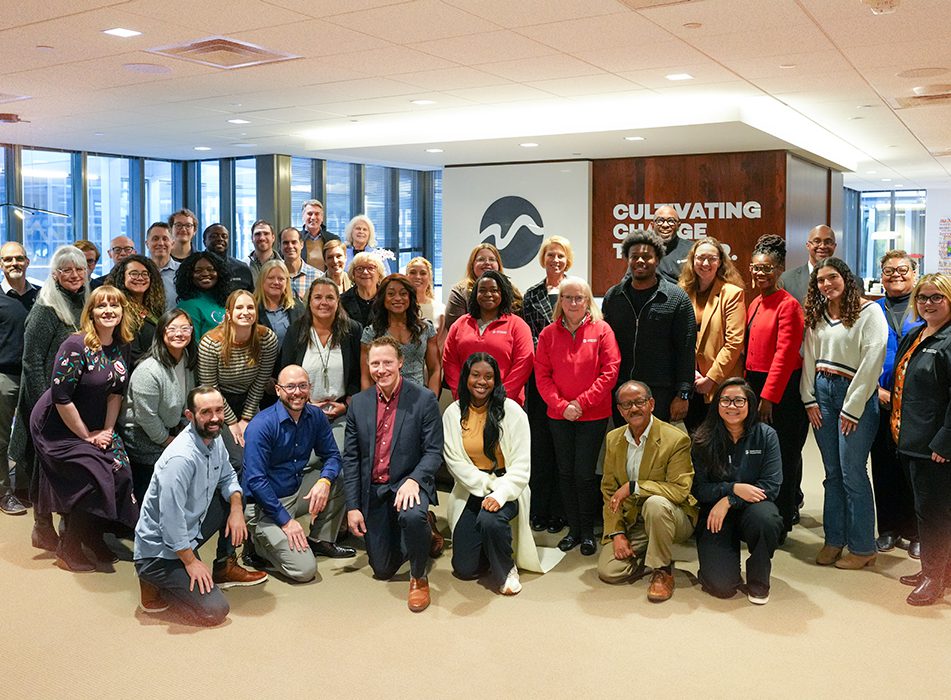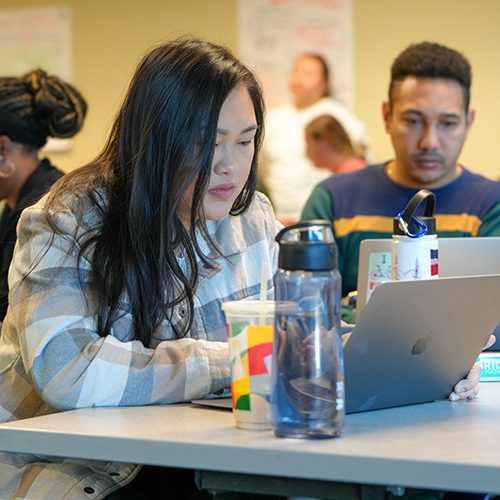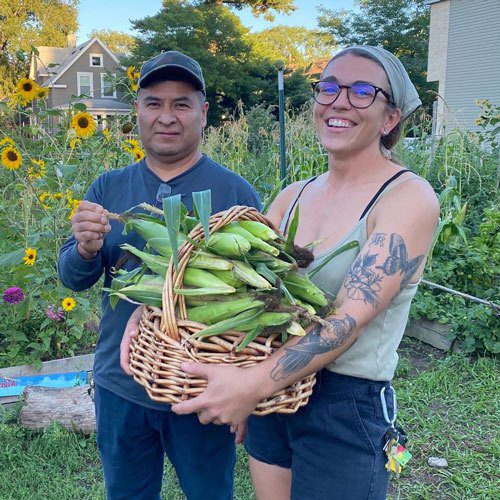Our Learning Hub is a place to learn, grow, and take action on important issues. Explore our latest stories and resources.
Our
Legacy

It Began
in 1915
A lawyer, two lumbermen, and two bankers came together with a vision: To create “a wisely planned and enduring fabric” that would benefit the community for years to come. They brought that vision to life by establishing the Minneapolis Foundation.
-

1922
Wells family legacy
The Wells family established their first fund in honor of Thomas Wells, beginning a multigenerational relationship with the Minneapolis Foundation.
1924
Protecting Our Natural Resources
Conservationist Frances Andrews helped secure federal protection of northern woods and wetlands in what eventually became the Boundary Waters. Her legacy continues today through a fund at the Foundation.
1926
MORE THAN JUST A BAND-AID
The Foundation became the fiscal agent for the University of Minnesota Medical School Endowment Fund.
1929
MORE THAN JUST A DISCO
The Village People aren’t the only ones dancing. As far back as 1929, the Foundation was doing the YMCA, too! Some of the Foundation’s earliest grants went to the YMCA, which continues to receive support from our donors. The Foundation is proud of our longstanding partnership with this community institution on projects that have ranged from renovation work to family counseling services to the majestic Camp Tamarac.
-
1930
THE CITY’S DEBT TO MR. BOUTELL
That was the news headline after Walter D. Boutell died. Boutell cared deeply about children and families, and his compassion lives on through a Foundation fund that still supports local hospitals and social services.
1931
An Early Minneapolis Library

Samuel Hill served as vice president of a private subscription library known as the Minneapolis Athenaeum. When he died in 1931, Hill owned hundreds of shares of Athenaeum stock, which he entrusted to the Minneapolis Foundation in his will. Today, the Minneapolis Athenaeum is housed at the Minneapolis Central Library, with a collection that includes an original hand-colored edition of Audubon’s “Birds of America” and important early books on Indigenous communities.
1932
QUALITY HEALTHCARE FOR ALL
The Visiting Nurses Association, an early Foundation grant recipient, built a workshop in downtown Minneapolis to better serve the community’s healthcare needs.
-
1941
Responding to PEARL HARBOR
Just weeks after the attack on Pearl Harbor, we approved a grant to the emergency fund of the American Red Cross.
1942
A MEDICAL PIONEER MOVES TO MINNEAPOLIS
Australian nurse Elizabeth Kenny, who revolutionized the treatment of polio, came to Minneapolis. The Sister Kenny Institute soon became a premier rehab center – and a Foundation grantee.
1943
COMMUNITY CHEST
During the 1940s, the Minneapolis Foundation made regular contributions to the Minneapolis War Chest and Community Chest (early United Way campaigns) to support social services.
In addition to sharing a Centennial, the United Way and the Foundation have something else in common: Flexibility. Together, we are continuing to meet the ever-changing needs in our community.
1945
A LUMBERMAN WITH AN EAR FOR TIMBRE
Lumberman E.L. Carpenter helped start both the Minneapolis Foundation and the Minneapolis Orchestra. When he died in 1945, the Minneapolis Tribune wrote, “Death Monday took the last of Minnesota’s empire builders, a man with the vision to see that the ring of the lumberjack’s saw could be transmuted into the deep resonance of a great orchestra.”
-
1950
A Hotel Gets a New Purpose
We purchased the Field Hotel on South Eighth Street in Minneapolis to help The Braille Center expand its counseling and nursing services for blind Minnesotans.
1952
THE ARTIFICIAL KIDNEY
Patients suffering from kidney disease took advantage of a new “artificial kidney,” the forerunner of dialysis, at what is now Hennepin County Medical Center, which was funded in part by the Foundation.
1957
public Television Comes to Minnesota
KTCA, now known as Twin Cities PBS (TPT), began broadcasting from a WWII-era wooden structure on the University of Minnesota Agricultural Campus. We are a longtime funding partner of Minnesota’s first non-commercial public television station.
1958
COFFEE WITH YOUR CONCERT?
That was the idea behind a series of daytime concerts by the Minnesota Orchestra that were underwritten by a fund at the Foundation.
-
1963
A THEATER FOR THE PEOPLE
The Guthrie Theater opened—with help from the Foundation, which contributed to construction.
1968
A Helping Hand in Times of Need
A longtime fund of the Minneapolis Foundation, the Minneapolis Emergency Fund was started as a resource for people in need. The fund made emergency grants to both individuals and human service organizations, helping members of our community in times of crisis.
1969
Providing Equal Opportunity
A group of wealthy Minneapolis-area families anonymously pooled their money to help people from low-income communities of color make down payments on homes and obtain seed money for businesses. This fund of the Minneapolis Foundation was called the Minneapolis Equal Opportunity Fund.
-
1970
WELCOME ABOARD, RUSSELL EWALD
We hired our first full-time executive director, Russell Ewald, and opened an office at the Chamber of Commerce building in Minneapolis.
1971
BUILDING MORE THAN JUST A MUSEUM
Mention the Walker Art Center, and many Minnesotans immediately think of the iconic sculpture Spoonbridge and Cherry. Since the museum opened in 1927, the Walker has received support from many Foundation donors. Some, for example, helped fund construction of the renowned building designed by architect Edward Larrabee Barnes, which opened in 1971.
1973
Tackling School Segregation
In what was then the largest grant in our history, we granted $130,000 to help the Minneapolis school district roll out an innovative desegregation program at three junior high schools.
1974
REVITALIZING THE PHILLIPS NEIGHBORHOOD
Project for Pride in Living has been working with The Foundation since the early 70’s to revitalize the Phillips neighborhood. In 1974, the Foundation supported the development of a renovation program for the Phillips neighborhood and, in 1979, partially funded the initial costs of developing a Section 8 rental housing project for low- and moderate-income families.
1975
KIDS DESERVE THEATER TOO
In 1975, The Minneapolis Foundation granted $15,000 to help the Children’s Theatre Company and School meet operational needs during its initial period as an independent organization. (Previously, it had been connected to the Minneapolis Society of Fine Arts.) The Children’s Theatre, which is approaching its 50th anniversary, woos young audiences from across the state with such unforgettable productions as Dr. Seuss’ How the Grinch Stole Christmas. The theater makes performances accessible to all children through free and subsidized tickets, and nurtures a love of theater in young children through its early education programming.
1978
HOLLYWOOD HISTORY LESSONS
We made a grant to the Jewish Community Relations Council to print and distribute a discussion guide to a television program called “The Holocaust,” which ran in April 1978.
-
1980
Rocket Fuel for Nonprofits
Started in 1980 as a program of the Minneapolis Foundation, Propel Nonprofits is now an independent organization that strengthens our community by supporting nonprofits with loans, training, practical guidance, and financial management resources.
1981
HITTING ALL THE RIGHT NOTES
The MacPhail Center for Music has been making beautiful music for over 100 years. In 1981, the Foundation hit all the right notes by covering costs for a new music performance program for Minneapolis adults.
1982
FIGHTING DOMESTIC VIOLENCE
Founded by Latina activists in St. Paul, Casa de Esperanza has fought to end domestic violence since 1982. In addition to running a crisis line and many other projects, the nonprofit produced My Girlfriend Did It, a groundbreaking documentary on interpersonal violence in lesbian relationships. The Foundation funded a screening of that film in 2008 – just one of the ways we’ve stood with Casa de Esperanza over the years.
1983
THE POWER OF WOMEN
A desire to remove barriers for women and girls led to the creation of the Women’s Fund at the Minneapolis Foundation. The fund eventually grew into a separate organization, the Women’s Foundation of Minnesota, now the nation’s oldest statewide foundation focusing on gender justice.
1984
Emma Howe
A frugal woman, Emma Howe was a proofreader and one of the first employees of Deluxe Check Printers. She was often paid in stock, and by the time she died in 1984, she was the largest individual shareholder of what had grown to be a Fortune 500 company. Her estate was worth $22 million—and she left much of it to the community. The fund bearing her name at the Minneapolis Foundation has supported AIDS research, pediatric cardiology, a teen center in the Minneapolis Public Library, and much more.
1985
ENDING TORTURE WORLDWIDE
There are more than 30,000 torture survivors in Minnesota. The Center for Victims of Torture has supported many of them at a Healing Center in St. Paul. But since its founding in 1985, the nonprofit has also grown into an international organization with global impact in advocacy, training and research. Through support of the Center, the Foundation and our donors are working to advance human rights and end torture worldwide.
1988
CONSTRUCTING THE WHITNEY BRIDGE
The Whitney Bridge spans some of the busiest traffic in the city and is a local landmark, connecting Loring Park with the Minneapolis Sculpture Garden. A 1988 grant from the Hixon Whitney Family Fund at the Foundation helped fund its construction.
1989
OPEN YOUR MIND, NOT YOUR WALLET
The Minneapolis Institute of Arts, one of the Minneapolis Foundation’s earliest grantees, was created in 1915 by the Minneapolis Society of Fine Arts.
In September 1989, museum director Evan Maurer announced that the museum would no longer charge a general admission fee. This new policy was evidence of the museum’s strong desire to make art more accessible to the general public and to eliminate barriers that might prevent full accessibility to the museum’s magnificent collection.
-
1993
FAST TRACK TO A LIVING WAGE
Founded by former General Mills executive Steve Rothschild, Twin Cities RISE! offers classes, one-on-one coaching, personal empowerment and internship opportunities to train low-income adults – mostly men of color – for skilled jobs that pay a living wage. Since 1993, the Minneapolis Foundation and our donors have given more than $2.7 million to help Twin Cities RISE! fight poverty through work skills training.
1994
WELCOMING OUR NEW NEIGHBORS
How’s this for Minnesota Nice? For twenty years, the Confederation of Somali Community has been helping immigrants build new lives in Minnesota. By connecting families with resources to help them apply for jobs, enroll in schools and navigate the health care system, the Confederation paves the way for them to become self-sufficient members of our community. Supporting the Confederation is one way the Foundation has extended a warm welcome to new neighbors.
1995
OSCAR HOWARD'S LEGACY
Oscar Howard, founder of Meals on Wheels, started a fund at the Minneapolis Foundation to provide scholarships for local youth, continuing his legacy of improving lives.
1996
Building Better Futures
For a special photo exhibit, residents in low-income neighborhoods in and around downtown Minneapolis were given cameras and asked to take pictures of what they thought was important where they lived. Their photos—of churches, community centers, quiet houses, and kids playing—were displayed in the lobby of the Guthrie Theater. The exhibit was just one piece of our Building Better Futures project—a ten-year, $20 million investment to reduce poverty and improve lives.
1999
REDEFINING "AFFORDABLE" HOUSING
We gave a special $250,000 grant to a collaborative of more than 70 organizations led by the Minnesota Housing Partnership and Tunheim, a public relations firm, to carry out Housing Minnesota, a statewide advertising campaign to change perceptions about affordable housing.
-
2001
EMERGENCY RESPONSE: 9/11
After the September 11 terror attacks, community foundations across the country immediately went to work to fund relief efforts for the families of the victims. Within days, Minneapolis Foundation donors and other community members responded generously to the appeal for aid. Foundation donors directed more than half a million dollars to relief efforts through the September 11th Fund, which was established by the New York Community Trust—a fellow community foundation—and the New York United Way.
2002
THINK TWICE
Tensions rose in 2002 as Minnesota lawmakers grappled over how to close a state budget gap of $1.95 billion. In late November, the governor’s budget director announced that all grants to nonprofit organizations would be frozen pending legislative action to address the shortfall. Recognizing the need for immediate action, the Minneapolis Foundation funded Think Twice, the Minnesota Council of Nonprofits’ first advertising campaign, to urge citizens to contact their elected officials during the legislative session and voice their support for the work of nonprofits in their community.
2005
Employee Assistance Funds
We partnered with Ken Melrose, retiring CEO, and The Toro Company to establish our first Employee Assistance Fund. In its first 18 years, the Melrose/Hoffman Employee Critical Need Fund distributed over $3.5 million to more than 500 Toro employees experiencing unexpected financial hardships.
2006
AN EXPLORATION OF RACE
The Minneapolis Foundation underwrote a free day at the Science Museum of Minnesota for patrons to view RACE, a national exhibition that tells the stories of race from biological, cultural, and historical points of view. RACE was a winner of the Excellence in Exhibition Competition at the 2008 meeting of the American Association of Museums.
2007
EMERGENCY RESPONSE: 35W BRIDGE
At 6 p.m. on August 1, the I-35W bridge in downtown Minneapolis collapsed into the Mississippi River, killing 13 people and injuring hundreds. The next day, then-Mayor R.T. Rybak asked us to open a fund that would enable people across our community to help. The Minnesota Helps – Bridge Disaster Fund was set up on August 3, and donations started pouring in. Ultimately, the fund collected and distributed more than $1.2 million to aid survivors and the families of those who died.
2008
"CLOSE THE GAP"
A six-part documentary on the region’s growing economic and social disparities, Close The Gap was broadcast on Twin Cities Public Television with support from the Foundation.
2009
MINNESOTANS GIVE TO THE MAX
With our support, Give to the Max Day was created by GiveMN to inspire giving to nonprofit organizations across the state by engaging as many donors as possible in one day. The first Give to the Max Day in 2009 raised $14 million for 3,434 Minnesota nonprofits.
-
2010
THE NEW WAVE OF PHILANTHROPY
We launched Fourth Generation, a program fostering rising leaders and changemakers. Members of this giving circle work together every year to learn about a critical issue, identify promising efforts to address it, and pool their resources to make a much bigger difference in the community than they could on their own.
2014
PARTNERSHIP FOR A GREENER FUTURE
The Minneapolis Foundation entered into a strategic partnership with RE-AMP, a network of 160 nonprofits and foundations across eight Midwestern states. Members of the network are working together on issues related to climate change and energy policy, with the goal of reducing global warming pollution economy-wide by 80 percent by 2050.
2015
CELEBRATING 100 YEARS OF INNOVATIVE COMMUNITY BUILDING
To celebrate 100 years of service and commitment to the Minneapolis community, the Minneapolis Foundation hosted the Face Forward Futurist Conference on Sept. 18 at the Minneapolis Convention Center. The conference drew more than 1,500 Twin Cities leaders and residents to learn about innovative approaches to some of the community’s biggest challenges and opportunities. Keynote speakers included physician Atul Gawande, physicist Michio Kaku, charity innovator Dan Pallotta, and longevity expert Dan Buettner. MPR host Kerri Miller served as the conference moderator, leading the day’s robust discussions. In addition, an array of local leaders shared their visions for the future during breakout sessions on community issues such as education, civic engagement, the arts, and economic vitality.
2016
InvestMPLS
Launched in 2016, this revolving loan pool enables our fundholders to tap into the power of impact investing, using charitable assets for hyper-loan loans that nurture small businesses, preserve affordable housing, and more—right here in Minneapolis.
2018
OneMPLS Fund
We started this collective impact fund to create a pathway for people across our community to join forces in response to urgent local needs. In its first five years, the OneMPLS Fund distributed $6 million to more than 160 nonprofits addressing issues such as affordable housing, pandemic relief, and more.
-
2020
A Framework for the Future
Unveiled after a co-creation process with partners across our community, our Strategic Framework states clearly that we have evolved in our approach to philanthropy. We strive to be responsive rather than prescriptive; to listen more deeply and get as close as we can to those most affected by injustice; and to organize all our work around measurable, positive outcomes in our community.
2020
A Year of Great Need
Within weeks of COVID-19’s arrival in Minnesota, we deployed our OneMPLS Fund to help our community withstand the pandemic’s economic impact. Within days of George Floyd’s murder, we committed an additional $500,000 to our Fund for Safe Communities to support Minneapolitans in pursuing justice, equity, and healing. Our response work deepened through 2020 and beyond through grantmaking, partnerships, impact investing, and more.
2022
Main Street Grants
To support recovery and rebuilding in along key commercial corridors that were hit hard by the events of 2020, we partnered with LISC Twin Cities, Propel Nonprofits, and later the Metropolitan Economic Development Association (Meda) to begin administering grants through the State of Minnesota’s Main Street Economic Revitalization Program.
Our Commitment to Learning
